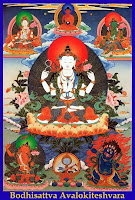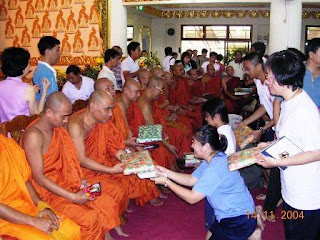The Dharma, A Way rather than a Technique
The methodologies for transcendence are varied: meditation, prayer, devotion, yoga, fasting, even psychotropic drugs. In the long run, the ones that are the most useful will be the ones that can be integrated into daily life wit the minimum amount of dependence on external circumstances or internal ideology.
Then, the method will be applicable to a wide range of people and it will not become the source of a more stressful mental activity, such is the spiritual alignment that the Buddha called "Dharma" and which he described as: Directly accessible, not bound up with any special events or times, encouraging interests and open mindedness (rather than belief), furthering and deepening, to be realized directly in one's experience through wisdom (rather than induced by another).
Dharma supports and is supported by practices such as careful reflective thinking, cultivation of kindness and compassion to oneself and others, calming the mind in meditation and gaining transcendent understanding of the phenomena that make up and arouse our mental activities. All of these practices are to be undertaken in the light of Dharma - that is by looking directly at the results and not subscribing to dogmatic views about any of it.
The vision of the Dharma is that if the mind is healed, strengthened and calmed, if we are no longer swept away by our ideas, doubts, plans, regrets, grudges and phobias, then we can cross the floods and to use a Buddhist metaphor, be standing on the "Other Shore". Whatever the analogy, such as transcendence means that we are neither generating stress nor caught in stressful consequences.
Accordingly, the most usual summary of the Buddha's Dharma is that it presents Four Noble Truth concerning suffering and stress or dukkha. These truths presents this stress and suffering as unavoidably bound up with the human condition, yet as something that has a cause and that the cause can be eliminated and finally there is a Path of practices that will lead to elimination of that stress.
Like any unfolding, the elimination of stress requires care. So in order to facilitate this, the Buddha's teaching encourages persistent strengthening, healing and refining of mental activity. To this end, he presented themes and instructions, often in clusters such as the five spiritual faculties or the seven factors of enlightenment.
The culmination of these is in meditative Dharma practices, ones that depend on a calm and secluded context to support close examination of the mind. If this were the only situation for the spiritual alignment of Dharma, it would limit the occasions in which such Dharma could be practised and narrow the meaning of Dharma to a set of meditation techniques.
However, when we consider how the Buddha defined Dharma and how he framed liberation quite broadly in terms of acknowledging and building a path out of suffering and stress, then we must also use a broader focus as a longer term foundation for the Dharma, one which will fit the context and energies of our active life.
Accordingly, a set of instructions called parami or paramita have become paramount in their usefulness and daily life applicability. The term parami and paramita carry meanings such as furtherances or perfections and refer to cultivating skillful intentions and action throughout the day.
Then, the method will be applicable to a wide range of people and it will not become the source of a more stressful mental activity, such is the spiritual alignment that the Buddha called "Dharma" and which he described as: Directly accessible, not bound up with any special events or times, encouraging interests and open mindedness (rather than belief), furthering and deepening, to be realized directly in one's experience through wisdom (rather than induced by another).
Dharma supports and is supported by practices such as careful reflective thinking, cultivation of kindness and compassion to oneself and others, calming the mind in meditation and gaining transcendent understanding of the phenomena that make up and arouse our mental activities. All of these practices are to be undertaken in the light of Dharma - that is by looking directly at the results and not subscribing to dogmatic views about any of it.
The vision of the Dharma is that if the mind is healed, strengthened and calmed, if we are no longer swept away by our ideas, doubts, plans, regrets, grudges and phobias, then we can cross the floods and to use a Buddhist metaphor, be standing on the "Other Shore". Whatever the analogy, such as transcendence means that we are neither generating stress nor caught in stressful consequences.
Accordingly, the most usual summary of the Buddha's Dharma is that it presents Four Noble Truth concerning suffering and stress or dukkha. These truths presents this stress and suffering as unavoidably bound up with the human condition, yet as something that has a cause and that the cause can be eliminated and finally there is a Path of practices that will lead to elimination of that stress.
Like any unfolding, the elimination of stress requires care. So in order to facilitate this, the Buddha's teaching encourages persistent strengthening, healing and refining of mental activity. To this end, he presented themes and instructions, often in clusters such as the five spiritual faculties or the seven factors of enlightenment.
The culmination of these is in meditative Dharma practices, ones that depend on a calm and secluded context to support close examination of the mind. If this were the only situation for the spiritual alignment of Dharma, it would limit the occasions in which such Dharma could be practised and narrow the meaning of Dharma to a set of meditation techniques.
However, when we consider how the Buddha defined Dharma and how he framed liberation quite broadly in terms of acknowledging and building a path out of suffering and stress, then we must also use a broader focus as a longer term foundation for the Dharma, one which will fit the context and energies of our active life.
Accordingly, a set of instructions called parami or paramita have become paramount in their usefulness and daily life applicability. The term parami and paramita carry meanings such as furtherances or perfections and refer to cultivating skillful intentions and action throughout the day.




Comments